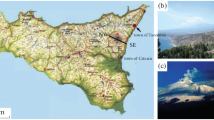Conclusions
-
1.
Effusive and intrusive petrochemical analogs differ considerably as regards their content of ordinary and mobile uranium. This is because of the fundamentally differing conditions of solidification of the chemically identical melts.
-
2.
As products of the rapid supercooling of aluminosilicate melts, effusives mechanically capture all the uranium dissipated within them, and as a result of the metastable state of the main mass fail to transfer this uranium to solutions without the complete chemical decomposition of the material composing them.
-
3.
The initial concentration and distribution of the uranium in volcanogenic rocks are altered when epigenetic processes associated with tectonic magmatism and metamorphism develop on the large scale. As they develop regional, local, contact, and hydrothermal forms of metamorphism lead to the appearance of different amounts of mobile uranium and to a change in the original content. Ultrametamorphism leads to the greatest losses of uranium.
-
4.
The most promising sites as regards the discovery of uranium ore-formation are regions of acid volcanism having widely evident areas of low- and medium-temperature hydrothermal metamorphism, with traces of later tectono-magmatic activization. No less favorable are regions corresponding to the propagation of early volcanogenic accumulations of the same composition which have experienced metamorphism of the greenschist facies and then been subjected to hydrothermal action.
Thus the uranium contained in volcanogenic rocks can only migrate after fundamental recrystallization of the rock-forming material, or after its complete decomposition, which may be effected either in metamorphic processes or alternatively in exogenic processes in which chemical decomposition of the rocks takes place. Effusive—explosive formations usually undergo the greatest metamorphic transformations in the epigenetic stage of their existence (a long time after the extinction of the volcanos), by virtue of the appearance of a superimposed deep tectono-magmatism influencing and basically modifying the volcanogenic strata.
Similar content being viewed by others
Literature Cited
I. Adams, Nuclear Geology, New York (1954).
I. Rocholt et al., Econ. Geol.,66, 1061 (1971).
L. N. Shatkova and G. A. Shatkov, Geologiya Rudnykh Mestorozhdenii, No. 4, 36 (1973).
V. P. Kovalev, Uranium and Thorium in Magmatic and Metamorphic Rocks in the Central Part of the Altae-Sayan Folded Region [in Russian], Nauka, Moscow (1972), p. 164.
V. P. Kovalev, Radioactive Elements in Rocks [in Russian], Nauka, Novosibirsk (1975), p. 95.
L. L. Leonova and N. I. Udal'tsova, Geochemistry of Uranium and Thorium in the Volcanic Process, the Kurile-Kamchatka Region Being Taken as an Example [in Russian], Nauka, Novosibirsk (1975).
A. A. Smyslov, Uranium and Thorium in the Earth's Crust [in Russian], Nedra, Leningrad (1974).
I. E. Smorchkov, in: Geology of Hydrothermal Uranium Sites [in Russian], Nauka, Moscow (1966), p. 119.
V. P. Kovalev and Z. V. Malyasova, Geokhimiya, No. 7, 855 (1971).
G. V. Kukolev, Chemistry of Silicon and Physical Chemistry of Silicates [in Russian], Vysshaya Shkola, Moscow (1966).
H. Sylwestrzak, Bull. Institut Geol., Warsaw (259),21, 5 (1972).
O. P. Eliseeva, B. I. Omel'yanenko, and I. E. Smorchkov, Zap. Vsesoyuz. Mineralog. Obshch.,103, 508 (1974).
G. Neuerburg, I. Antweiler, and B. Bieler, 20th Intern. Geol. Congress, Abstracts, Mexico (1956), p. 221.
N. A. Kulik, S. V. Mel'gunov, and V. M. Gavshin, in: Radioactive Elements in Rocks [in Russian], Nauka, Novosibirsk (1975), p. 229.
A. S. Mitropol'skii, V. P. Kovalev, and S. V. Mel'gunov, in: Geochemistry and Conditions of Gold and Rare-Metal Ore Formation [in Russian], Nauka, Novosibirsk (1972), p. 88.
Additional information
Translated from Atomnaya Énergiya, Vol. 41, No. 2, pp. 85–91, August, 1976.
Rights and permissions
About this article
Cite this article
Kovalev, V.P., Nozhkin, A.D., Mironov, A.G. et al. Redistribution and mobility of uranium during the metamorphism of volcanogenic formations. At Energy 41, 697–703 (1976). https://doi.org/10.1007/BF01132642
Received:
Issue Date:
DOI: https://doi.org/10.1007/BF01132642




